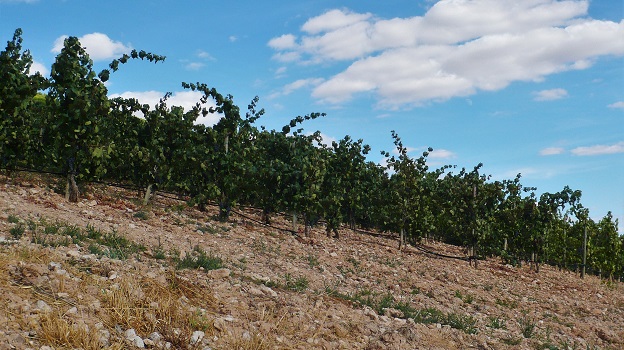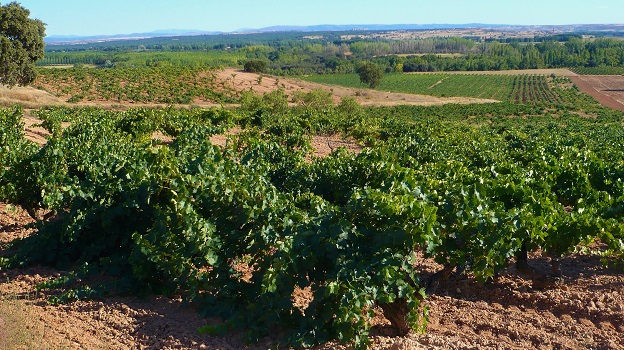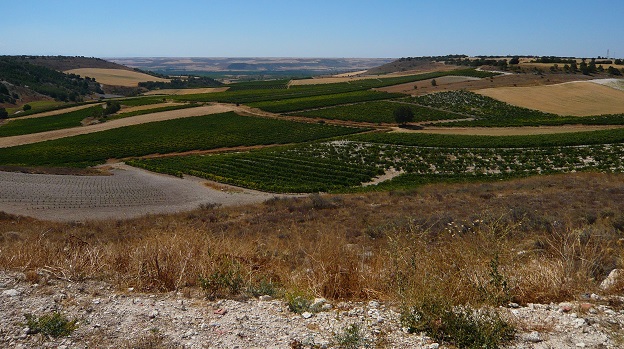Browse using the new Vinous website now. Launch →
Printed by, and for the sole use of . All rights reserved © 2015 Vinous Media
Central Spain: Tempranillo and Beyond
Central Spain is a distinctly homogeneous area, geographically speaking. The majority of its red wines are made entirely, or in large part, from Tempranillo, which is Spain’s single most esteemed variety and the grape that most often places the country among the world’s elite wine-growing regions. Central Spain’s white wines are fairly uniform in varietal makeup as well, with the Verdejo grape taking center stage.
Tackling the complex subject of “Spanish wine” has never been easy given the vast number of regions that stretch from one side of the country to the other. In the interest of efficiency, we have divided the country into several macro regions: Northern Spain (mostly white wines with an Atlantic influence as well as some lighter, high-acid reds), Central Spain (more continental in climate and the home of the Tempranillo variety), and Mediterranean Spain (a bit more of a mixed bag, as this area includes brawny, high-octane wines with a distinctly southern twang as well as brighter, more elegant wines from Catalonia). Because of its sheer number of high quality wines, Rioja is covered separately. Sherry, another unique Spanish vinous treasure, will be the subject of a forthcoming article.
2015 Tempranillo in Pesquera de Duero, almost ready to go
Getting a Lay of the Land
Given its topography, very little Spanish vineyard land can be considered low-lying. The country is basically an elevated plateau. Except for some vineyards in Rías Baixas in the extreme northwest, all of the major grape-growing regions of the country are planted at elevations that ensure dry, windy conditions. That greatly diminishes the risk of rot, not to mention pest issues and, as a result, Spain benefits from having some of the oldest vineyards on earth. Much of this region is essentially a single big, sprawling vineyard broken up by villages and cities, as anybody who has driven west from Valencia to the Portuguese border can attest. In fact, this area, most of which is known as Castilla-La Mancha, is the most heavily planted wine region in the world, comprising nearly 1.2 million acres of vines. About 50% of Spain’s grapes are grown here, which means just over 16% of all the grapes grown in Europe. You won’t be reading about the wines (or the distilled spirits that are based on them) that come from most of these sites and, believe me, that’s a good thing.
Central Spain: The Mother Lode of Tempranillo
Two of Spain’s vinous crown jewels are located here: Rioja (covered extensively last month) and Ribera del Duero. Rioja and Priorat (the latter region to be covered in my article on Mediterranean Spain), are the only two Spanish wine-growing regions to be awarded DOC (Denominación de Origen Calificada) status, which in effect makes them the country’s grand cru zones. The best parts of Ribera del Duero, notably the vineyards around La Horra, Pesquera and Valbuena and the very hilly Soria area farther to the east, produce Tempranillo-based wines that easily rival the best that Rioja has to offer, albeit in a bolder expression. But the region is too heterogeneous in terms of weather conditions, altitudes and soils, I believe, to warrant the entire zone’s elevation from DO to DOC. In fact, Rioja itself, which encompasses three sections--Rioja Alta, Rioja Alavesa and Rioja Baja--really doesn’t deserve to be entirely classified as DOC either, in my opinion, as the wines from the hotter, drier, more southern Baja area, which is heavily planted to Garnacha, can rarely hold a candle to those sourced from cool, hilly, even mountainous Rioja Alta and Alavesa.
Tempranillo vines in Peñafiel just before the 2015 harvest
Ribera del Duero vs. Rioja
Owing to the generally warmer climate of Ribera del Duero, its wines are usually deeper, richer and more dark fruited in character than their Rioja cousins, not to mention higher in alcohol and lower in acidity. That’s also because, with rare exception, the wines are made entirely from Tempranillo, while most of the best Riojas also include some Garnacha, Graciano and/or Mazuelo (a.k.a. Cariñena), with these latter varieties adding elements of fruitiness, acidity and spine to the wines. There’s also a greater tendency for Ribera producers to use more new oak, often in the form of small casks, than is normally the case in Rioja’s bodegas where larger, older wooden vessels are more often the rule. In very general terms, most Ribera del Duero wines lean toward Napa Valley while most Riojas are more Bordeaux-like.
The best white wines of central Spain mostly come from Rueda, which lies just southwest of Ribera del Duero. While there are random examples of oaked, weighty Rueda wines, such wines are decidedly the exception; the vast majority of the region’s wines are raised entirely in stainless steel and occasionally concrete tanks. A typical Rueda will be racy and dry, leaning to citrus fruits and often showing herbal and floral accents. There’s a decided Sauvignon Blanc-ness to many of the wines and, in fact, there’s also a good amount of that variety planted in Rueda. Although the Sauvignon Blancs can be very good, I tend to look for Ruedas that are made entirely from Verdejo—and with rare exception, you’ll find that fact indicated on the front or back label.
Castillo de Peñafiel, in the heart of Ribera del Duero
Central Spain’s other Top Sources of Red Wine
While Rioja and Ribera del Duero command most of the attention of red wine fans when it comes to this part of Spain, a number of other zones are also doing serious work, most notably Toro. This DO’s vineyards now total almost 150,000 acres, compared to “only” about 50,000 acres in Ribera del Duero, but to this point Toro has far fewer bodegas turning out world-class wines than their better-known neighbor. The vast majority of Toro juice is either bottled by cooperatives, blended away into anonymous regional wines, or simply sold off in bulk. That’s a shame because the region is rich in very old Tempranillo plantings (locally known as Tinta de Toro), and its top producers, such as Numanthia, owned by the LVMH group; Pintia, owned by the internationally renowned Vega Sicilia winery of Ribera del Duero; Bodegas Elias Mora and Bodegas Teso La Monja are among Spain’s elite. Toro’s weather is very dry and daytime temperatures can soar, but it’s usually quite cool at night during most of the growing season, which ensures good acid retention in the grapes. At their best, Toro’s reds combine the aromatic complexity and balance of Ribera del Duero wines with the brawn and richness of reds from hotter climes. Alcohol levels regularly reach 15% or even higher in Toro, which adds to their impression of richness and weight.
Exciting work is also being done today in the still relatively obscure Vinos de Madrid region, which was only given DO status in 1990. There are just over 15,000 acres of vines spread across more than 50 villages here, which has kept production spread relatively thin so far, but the few wines that have been trickling out into the international market in recent years are often outstanding, especially those made from, or based on, Garnacha. The wines made by Bodegas Bernabeleva, for example, deliver remarkable value, with the red fruit, spice and floral character of the most elegant Grenache-based southern Rhône reds and the depth to age.
Old bush vine Tempranillo in La Horra
Recent Vintages
As with most of Europe, the central wine-growing zones of Spain suffered mightily in 2013, starting with a cold, wet spring that severely affected flowering. Ribera del Duero, which enjoyed a relatively warm and dry summer, definitely enjoyed the ripeness edge over Rioja, which struggled with cooler weather, rain and resulting rot. Cool harvest-time conditions in Ribera del Duero’s vineyards ensured good acid retention. Fans of zestier Tempranillos will be pleased with plenty of ‘13s. As Peter Sisseck of Pingus and Hacienda Monasterio told me, “cool-year Ribera is almost always preferable to hot-year Ribera” because leaner, high-acid wines are more flexible than heavy, roasted wines at the dinner table.
Two thousand twelve was another matter, and a good one aside from the fact that the crop was short. The Riberas are concentrated, lively wines that possess good but not massive structure, with the tannins and requisite acidity to ensure positive evolution in the cellar. Few of these wines have the tannins to actually require patience, which should make them appealing to those who like to drink their wines in the fruity glory of youth. That said, the best 2012s possess good depth and balance, so they should reward mid-term cellaring even if they’re not quite built for the long haul.
The view from atop Emilio Moro's Malleolus vineyard in Pesquera de Duero
You Might Also Enjoy
The Many Facets of Rioja, Josh Raynolds, November 2015
Focus on Spain, Josh Raynolds, November 2014
-- Josh Raynolds
Show all the wines (sorted by score)
- Alianza de Garapiteros
- Antonio Sanz
- Atalayas
- Avelina Vegas
- Baron de Ley
- Bodega Bernabeleva
- Bodega Biniagual
- Bodega Cyan
- Bodega Elias Mora
- Bodega La Legua
- Bodega Lui & William Wines
- Bodega Matarromera
- Bodega Numanthia
- Bodegas Aalto
- Bodegas Abanico
- Bodegas Aldial
- Bodegas Alejandro Fernández
- Bodegas Aletta
- Bodegas Allegro con Spirito
- Bodegas Alto Moncayo
- Bodegas Alvarez y Diez
- Bodegas Angel Rodríguez
- Bodegas Arlese
- Bodegas Arrocal
- Bodega S. Arroyo
- Bodegas Arúspide
- Bodegas Asenjo & Manso
- Bodegas Astrales
- Bodegas Ateca
- Bodegas Barco de Piedra
- Bodegas Borsao
- Bodegas Breca
- Bodegas Camino Alto
- Bodegas Castillo de Maluenda
- Bodegas Cepa 21
- Bodegas Convento de Las Claras
- Bodegas Copaboca
- Bodegas Cyatho
- Bodegas D. Mateos
- Bodegas Emilio Moro
- Bodegas Fariña
- Bodegas Félix Solis
- Bodegas Fernando Remírez de Ganuza
- Bodegas Filón
- Bodegas Finca Los Aljibes
- Bodegas Fuentespina
- Bodegas Garci Grande
- Bodegas Hermanos Pérez Pascuas
- Bodegas Hesvera
- Bodegas Hidalgo
- Bodegas Hijos de Alberto Gutierrez
- Bodegas Hornillos Ballesteros
- Bodegas J.A. Calvo Casajús
- Bodegas Jimenez-Landi
- Bodegas La Horra
- Bodegas La Milagrosa
- Bodegas Langa
- Bodegas Más Que Vinos
- Bodegas Mureda
- Bodegas Mustiguillo
- Bodegas Naia
- Bodegas Olarra
- Bodegas Ordoñez-Ribera del Duero
- Bodegas Ordoñez-Rueda
- Bodegas Ordoñez-Toro
- Bodegas Palacios Remondo
- Bodegas Paniza
- Bodegas Pedro Escudero
- Bodegas Pedro Regalado
- Bodegas Peñalba Herraiz
- Bodegas Protos
- Bodegas Reina De Castilla
- Bodegas Rejadora
- Bodegas Roquesán
- Bodegas Santa Eulalia
- Bodegas San Valero
- Bodegas Sinforiano
- Bodegas Sucesores de Manuel Piquer
- Bodegas Tavera
- Bodegas Terra Sigalata
- Bodegas Teso La Monja
- Bodegas Tinedo
- Bodegas Torrederos
- Bodegas Torreduero
- Bodegas Torremorón
- Bodegas Traslascuestas
- Bodegas Vega Sicilia
- Bodegas Venta Morales
- Bodegas Viña Vilano
- Bodegas Virgen de la Sierra
- Bodegas Vizcarra
- Bodegas Volver
- Bodegas Y Vinedos Alfredo Santamaria
- Bodegas y Viñedos Alion
- Bodegas y Vinedos Anzil
- Bodegas y Viñedos Contralto
- Bodegas y Viñedos del Marqués de Vargas
- Bodegas y Viñedos de Nieva
- Bodegas y Viñedos Garciarevalo
- Bodegas y Viñedos Juan Manuel Burgos
- Bodegas y Viñedos Marqués de Tomares
- Bodegas y Vinedos Maurodos
- Bodegas y Vinedos Monteabellón
- Bodegas y Vinedos Pintia
- Bodegas y Vinedos Recoletas
- Bodegas y Viñedos Shaya
- Bodegas y Vinedos Viña Mayor
- Buil & Giné
- Colas Viticultores
- Comando G
- Compañia de Vinos Telmo Rodríguez
- Constantes Vitales
- Convento Oreja
- Convento San Francísco
- Crianzas y Viñedos Santo Cristo
- CVNE (Compania Vinicola del Norte de Espana, Cune)
- Dacu
- Dehesa de los Canónigos
- Dominio de Atauta
- Dominio de Eguren
- Dominio de Fontana
- Dominio del Aguila
- Dominio de Pingus
- Ebaño Viñedos y Bodegas
- Elvi Wines
- Estancia Piedra
- Familia Vidal
- Finca Antigua
- Finca Caserio de Dueñas
- Finca de Castilla
- Finca El Peñiscal
- Finca Montepedroso
- Finca Museum
- Finca Villacreces
- Finca Volvoreta
- Flaco
- Goyo García Viadero
- Grandes Vinos y Viñedos
- Hacienda Monasterio
- Haday
- Hammeken Cellars
- Infraganti
- Isaac Fernandez Seleción
- Javier Sanz
- La Portilla
- Las Rocas de San Alejandro
- La Viña del Loco
- Lechuza
- Legaris
- Los Dos
- Mano a Mano
- Manuel Manzaneque Suarez
- Marques de Almonacid
- Marques de Griñon
- Marqués de Irún
- Marques de Montañana
- Matiz
- Miguel Arroyo Izquierdo
- Montebuena
- Olivier Rivière
- Pago de Carraovejas
- Pago el Almendro
- Pagos de Lavego
- Pagos del Rey
- Pago Venta La Ossa
- Palacio de Bornos
- Palacio de Menade
- Pipón
- Quinta Milú
- Real Compañia de Vinos
- Rodriguez Sanzo
- Rolland Galarreta
- Sábato
- Tres Ojos
- Viña Mambrilla
- Viña Sastre
- Viñas de Alange
- Viñedos Alonso del Yerro
- Viñedos y Bodegas García Figuero
- Viñedos y Bodegas Gormaz
- Viñedos y Bodegas Pablo
- Vinos Ambiz
- Vinos La Zorra
- Yasa
- Yaso
- Zestos





